Progress report for GS24-302
Project Information
Potato (Solanum tuberosum) is a major commodity in Northeast Florida (NEF), producing up to 66% of United States winter potatoes. Among many pests of potatoes, sting (Belonolaimus longicaudatus) and stubby-root nematodes (Nanidorus minor and Nanidorus obtusus) are important in NEF. A cropping sequence of continuous winter potato followed by summer sorghum-sudan grass (Sorghum x drummondii) cover crop is typical in NEF, but both crops increase sting and stubby-root nematodes. Therefore, chemical nematicide application is the main nematode management tactic in the area. This project focuses on assessing various summer and fall cover crops as an alternative method for managing sting and stubby-root nematodes as well as their effects on and free-living nematodes (beneficial, non-parasitic) in potatoes. We will conduct a field trial where we will plant summer cover crops, sorghum-sudan grass and sunnhemp (Crotolaria juncea), followed by fall cover crops, arugula (Eruca sativa) and caliente mustard (Brassica juncea), before potatoes. We will compare cover crops to weedy fallow with or without the fumigant nematicide 1,3-dichloropropene (1,3-D). We will assess sting, stubby-root, and free-living nematodes regularly during the trial. The field trial is a continuation of work done in 2022/23 that needs to be repeated for validation. Further, we will do repeated greenhouse experiments to assess the host suitability of sting nematodes to different cover crops. These studies will provide potato growers with important information on efficacy of selected summer and fall cover crops for reducing sting and stubby-root nematode damage and maintaining beneficial nematodes.
The overarching goal of this project is to improve sting and stubby-root nematode management in potato production by using effective summer and fall cover crops combinations while minimizing negative impacts on soil populations of free-living nematodes.
The specific objectives of this project are to:
1) Evaluate summer cover crops, fall cover crops, and their combinations in field potato production for:
- Management of sting and stubby-root nematode populations
- Influence on potato yield; and
- Impact on beneficial, free living nematode communities.
2) Test the host suitability of sting nematodes to fall and summer cover crops in greenhouse conditions.
Research
Our primary objective is to assess the effectiveness of various combinations of summer and fall cover crops in managing sting and stubby-root nematodes in potato production. From the funding in this project, we have completed a repeated greenhouse trial and a field trial is in progress.
Methods (Field): The field trial is being conducted at the University of Florida Hastings Agricultural Education Center (HAEC) in Northeast Florida. The experiment is a randomized complete block design (RCBD) in split-plot arrangement with 8 treatments (2 summer main plot x 4 fall split-plot treatments). Summer cover crops treatments include 1) sunnhemp (cv. Crescent Sunn) and 2) sorghum-sudan grass (cv. Defiance). Fall treatments include 1) caliente mustard (cv. Rojo), 2) arugula (cv. Nemat), 3) weedy fallow, and 4) weedy fallow followed by 1,3-D fumigation. We have 6 replications for each treatment in a block for a total of 48 plots.
Summer cover crops (sunnhemp and sorghum-sudan grass) were already established in April 2024. Any activities occurring before September 2024 were not funded by this grant based on the funding cycle, but are included to give a full description of the project. Summer cover crops were planted with a single drill line on raised beds, each in 4 rows of 26 m long plot spaced 102 cm apart, which are standard practices in Northeast Florida We terminated these summer cover crops after about 4 months using a mechanical chopper and incorporated the residues into soil. Prior to cover crop termination, we took biomass of cover crops and weeds around cover crops using two 1 m2 quadrats per plot to measure fresh and dry biomass of cover crops.
Approximately 5 weeks after summer cover crop termination, we planted fall cover crops; caliente mustard and arugula in the selected plots with remaining plots left as weedy fallow. We terminated caliente mustard and arugula after about 2 months and took fresh and dry weight of each species at their termination. A week later, one of the fallow treatment plots was injected with 1,3-D (Telone II®) @ 66.2 kg a.i/ha. into the soil (approximately 25cm deep) with one shank per bed. Then 5 weeks later (mid-January) we planted potato seed pieces (Red Lasota) on the raised bed.
We have taken soil samples at fall cover crop termination, and potato mid-season as of now to assess soil abundances of sting nematodes, stubby-root nematodes, and free-living nematodes. The nematode abundance data at fall cover crop termination has been analyzed and mid-season assessment is ongoing. Additional soil sampling for nematode abundances at potato harvest, along with potato yield will be conducted as the season progresses. Also, the cover crop biomass data assessment is ongoing.
Methods (Greenhouse)
The objective of greenhouse experiment was to test host suitability of sting nematode to different summer and fall cover crops. For this, we selected 5 different crops 1) caliente mustard (cv. Rojo), 2) arugula (cv. Nemat) 3) carinata (cv. NUJET 400) 4) sunnhemp (cv. Crescent Sunn) and 5) sorghum-sudan grass (cv. Defiance) for their ability to reproduce in sterilized soil inoculated with same amount of sting nematodes. Caliente mustard and arugula are selected as potential fall cover crops, and carinata could serve as a winter cover crop. The relationship of all these cover crops with sting nematode is yet to be established. Sunnhemp is selected because it is a non-host crop and sorghum-sudan grass is a good host of sting nematode. Each treatment were replicated 6 times using RCBD for a total of 30 pots. Two greenhouse trials (Trial I and Trial II) were completed.
Greenhouse Culture set up: The pure culture of sting nematode was established in greenhouse using the species obtained from a naturally infested field at HAEC. This culture was used as an inoculum for greenhouse experiments.
Greenhouse Experiment: We grew all the cover crop seeds in a 15-cm-diameter pot containing sterilized soil in a greenhouse at the UF Entomology and Nematology Department in Gainesville, FL. Clay pots with a 15 cm diameter were filled with 1000 cm³ of the autoclaved soil. Six seeds were initially planted in each pot, but two weeks later the seedlings were thinned to one per pot. Sting nematodes were inoculated into the pots 18 days after planting (DAP) in Trial I and 25 DAP in Trial II. For sting nematode inoculation, four holes of 2.5 cm deep were made around each plant, and the nematode inoculum was evenly distributed into the holes using a pipette. Each pot received a total of 100 sting nematodes in 4 mL of solution. Plants were maintained and terminated at 60 days for Trial I and 58 days for Trial II. For all tested plants, sting nematode abundance was quantified by extracting nematodes from 100 cm³ of soil per pot which is an important variable for this greenhouse study. From soil abundance of sting nematode, reproduction factor (RF) was calculated to verify the host status of cover crops tested. Other supporting data on plant height and growth stage (number of leaves) were recorded 30 days after nematode inoculation and again at trial termination. Fresh shoot and root biomass were measured at termination.
Greenhouse study
In the greenhouse study, data were analyzed separately by trial because most variables had trial-by-treatment interactions (ANOVA, P ≤ 0.05). One-way ANOVA was performed for all the variables to determine the differences among treatments. For each variable, if the treatment effects in ANOVA were significant (P ≤ 0.05), Tukey’s HSD test was conducted to separate the means (α=0.05).
In both trials, sting nematode soil abundances were significantly higher for arugula compared to sorghum-sudangrass and sunn hemp (Figure 1). Sorghum-sudangrass is currently the most common cover crop in the region, although a few farmers have adopted sunn hemp. Caliente mustard and carinata also supported higher sting nematode populations than sunn hemp but were similar to sorghum-sudangrass. Among the brassica crops, there were no significant differences, except arugula supported higher populations than carinata in Trial 1. Sunn hemp had the lowest sting nematode abundances in both trials, except it was similar to sorghum-sudangrass in Trial 1.
Reproduction factors (RF) of sting nematode (ratio of final population to initial inoculated population) followed a similar trend as that of sting nematode soil abundances (Figure 2). The reproduction factor (RF) was > 1 for all the brassica crops and sorghum-sudangrass, which indicated that they were good hosts of sting nematode. Sunn hemp had RF<1 indicating a poor sting nematode host.
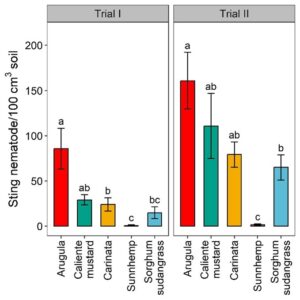
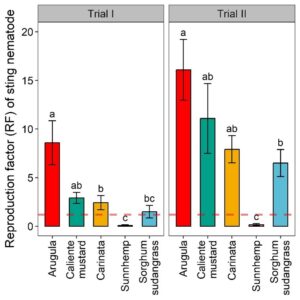
Field study
To analyze the nematode abundance at fall cover crop termination, one-way ANOVA was performed to assess differences between the treatments. If the treatment effects in ANOVA were significant (P ≤ 0.05), Fisher’s protected LSD (α = 0.05) was done to separate treatment means.
Results indicated no significant interaction between summer and fall treatments, so data were analyzed separately for each season. Among the summer cover crops, sunnhemp significantly reduced sting nematode populations compared to sorghum-sudangrass (Figure 3), while stubby-root nematode populations were not affected by summer treatments (Figure 4). With fall treatments, caliente mustard significantly increased sting nematode populations compared to fallow (Figure 5), while arugula supported intermediate sting nematode populations and was not different from other treatments. At this time point, the 1,3-D treatment had not been fumigated yet, so it was effectively another fallow treatment. Both arugula and caliente mustard increased stubby-root nematode populations compared to either fallow treatment (Figure 6). Beneficial free-living nematodes were not affected by fall treatments (data not shown), except that bacterivore nematodes that were significantly greater following arugula and caliente mustard cover crops than the 1,3-D fallow treatment (Figure 7).
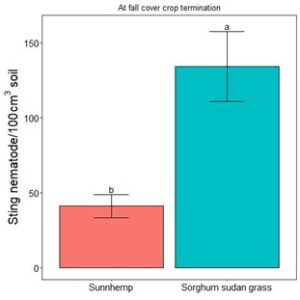
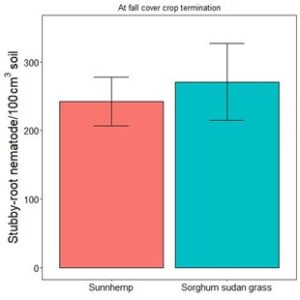
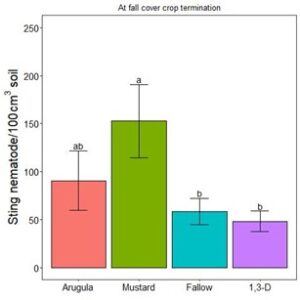
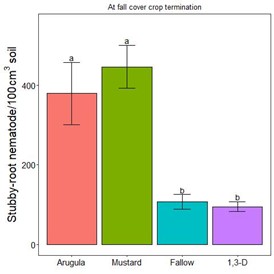
The conventional system for managing sting nematodes in Northeast Florida is using 1,3-Dichloropropene fumigant nematicide. Based on greenhouse study and results obtained so far from field study, sunnhemp which is tested as a summer cover crop showed promise in reducing sting nematode populations, especially relative to sorghum-sudangrass, which is currently common in the area. This suggested that sunn hemp could serve as a sustainable alternative for reducing sting nematode. Arugula and caliente mustard are relatively new cover crops to this region and not tested for nematode management previously. These new cover crops did not show effectiveness in suppressing sting or stubby-root nematodes.
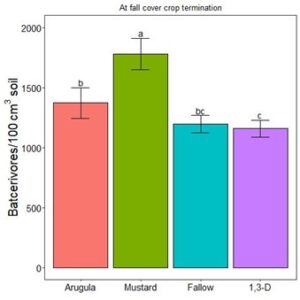
Educational & Outreach Activities
Participation Summary:
We presented our preliminary findings from this project at the 2025 Hastings Potato Field Day. One peer-reviewed journal article has been submitted, based on the greenhouse work. Once the field work is completed, we intend to summarize the work in an Extension/trade journal outlet so it is accessible to farmers.
Project Outcomes
This project has the potential to contribute to agricultural sustainability by managing sting and stubby-root nematode problems in potato farming. Based on the field and greenhouse study of this project so far, using cover crop species like sunn hemp in rotation can help minimize sting nematode issues in potato. Adopting this sustainable approach will help farmers manage sting nematodes and may be a step toward reducing reliance on fumigant nematicides for management, which is common now. This can help support beneficial organisms such as free-living nematodes which play a role in maintaining soil health. The improved soil quality can result in higher potato yields and better-quality of potatoes. This can also lead to improved economy of the growers and enhance consumer satisfaction, which supports the social well-being of the consumers.
During the course of this project, our understanding of sustainable agriculture has improved. We’ve gained some useful insights and understanding about how cover crops can help manage plant-parasitic nematodes (PPNs) like sting nematode and how certain cover crops can actually make the problem worse. We also saw that while certain cover crops enhance beneficial nematodes like bacterivores, they can also increase PPN population, which is something to keep in mind when making management decisions. This project has also enhanced our perspective on the practical challenges growers could face when adopting sustainable practices such as growing cover crops and establishing them properly.